What is FormsApp
FormsApp.exe is an adware program. Adware is unwanted software designed to display advertisements to make money for its developer, and can show ads in the form of pop-up windows, full screen ads, videos, audio ads, banner displays, and many more. These ads may appear in the form of windows you can’t close no matter how or where you click, or annoying pop-ups that never seem to end.
Typically, adware such as FormsApp can infect a personal computer in many ways, the most common of which involves downloading infected files as well as hacked software, freeware, Windows/Office key generators and other similar software.

FormsApp.exe can display unwanted advertisements to computer users
QUICK LINKS
FormsApp.exe adware can redirect your searches, change browser settings, install multiple toolbars, display banner ads, full-screen advertisements, pop ups, videos, or other varieties of online advertising. Maybe you approve the idea that the ads or pop-ups are just a small problem. But these unwanted advertisements eat computer resources and slow down your web-browser performance.
Another reason why it is necessary to remove FormsApp.exe is that it is able to monitor and report on your activity and provide information to a third party. It can install a component (spyware) that enables its creators to track which web pages you visit, what products you look at upon those pages. They are then choose the type of ads they show you. So, if you have adware installed on your personal computer, there is a good chance that you have another that collects and shares your sensitive information with third parties without your consent.
To summarize, FormsApp adware can lead to malware infection and financial losses. It can seriously affect your privacy, your computer’s performance and security.
How does FormsApp get on your computer
Most adware gets installed when users visit an infected website, download a malicious app, or click on a link or an attachment, install freeware that includes a bundled program. Sometimes it is possible to avoid the setup of any adware: run only reputable software which download from reputable sources, never install any unknown and suspicious apps, keep internet browser updated (turn on automatic updates), use good antivirus software, double check freeware before install it (do a google search, scan a downloaded file with VirusTotal), avoid malicious and unknown web pages.
Threat Summary
| Name | FormsApp, “FormsApp.exe”, “FormsApp virus”, “FormsApp.exe software” |
| Type | adware, potentially unwanted program (PUP), pop-up advertisements, pop-up virus |
| Related software | 42c6d9.msi, FormsApp Installation.msi |
| Detection names | Adware.Win32 |
| Symptoms |
|
| Removal | FormsApp removal guide |
Malware examples
On the Internet, users can come across many malicious programs that perform various malicious actions. Among them there are such as DPD Delivery Email virus, Wacatac trojan, Advanced Windows Manager, Dropbox Update Setup virus, Numando malware and AnarchyGrabber Stealer, although, of course, there are many more. Some of them collect user data, others install malware on computers, and still others add infected computers to botnets, and so on. In any case, each malicious program (adware, browser hijacker, trojan, worm, …) is a huge threat to both user privacy and computer security. Therefore, malicious programs must be removed immediately after detection; using an infected computer is very dangerous.
How to remove FormsApp from computer (Adware removal guide)
We can help you remove FormsApp.exe from your computer without the help of a professional. Just follow the removal guide below if you currently have malicious adware installed on your PC and you want to remove it. If you are having difficulty trying to get rid of the adware, feel free to contact us for help in the comments section below. Read it once and then bookmark this page (or open it on your smartphone) as you may need to exit your web browser or restart your computer.
To remove FormsApp, use the following steps:
- Kill FormsApp adware
- Disable FormsApp start-up
- Uninstall FormsApp related software
- Scan computer for malware
- Reset Google Chrome
- Reset Internet Explorer
- Reset Firefox
Kill FormsApp adware
Press CTRL, ALT, DEL keys together.
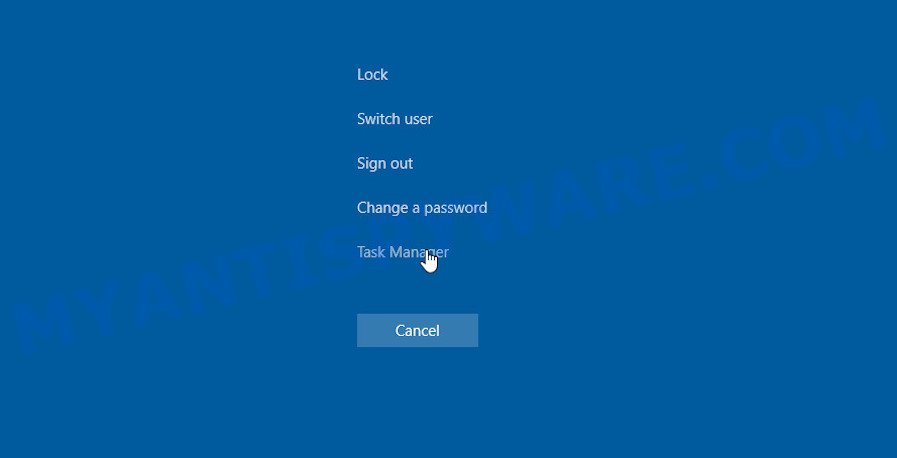
Click Task Manager. Select the “Processes” tab, look for “FormsApp Application © 2022”, “FormsApp.exe”, “FormsApp © All rights reserved” or “FormsApp product” then right-click it and select “End Task” or “End Process” option. If your Task Manager does not open or the Windows reports “Task manager has been disabled by your administrator”, then follow the guide: How to Fix Task manager has been disabled by your administrator.
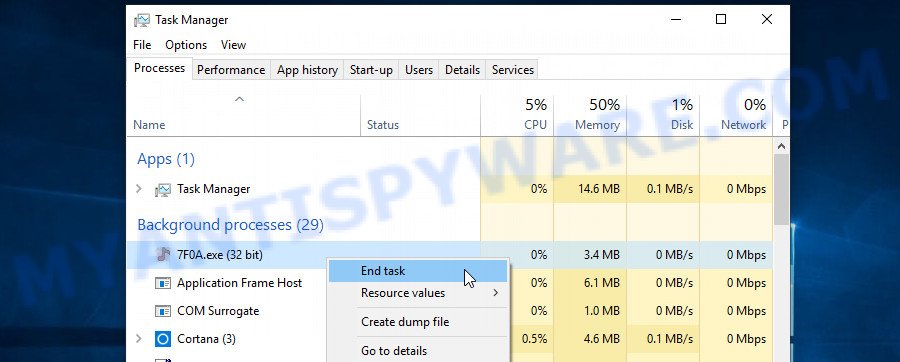
Adware can mask itself to avoid detection by imitating legitimate Microsoft Windows processes. A process is particularly suspicious: it’s taking up a lot of memory (despite the fact that you closed all of your applications), its name is not familiar to you (if you’re in doubt, you can always check the program by doing a search for its name in Google, Yahoo or Bing).
Disable FormsApp start-up
Select the “Start-Up” tab, look for something suspicious that is the FormsApp app, right click to it and select Disable.

Close Task Manager.
Uninstall FormsApp related software
Check the list of installed apps on your computer and remove all unknown and recently installed apps. If you see an unknown program with incorrect spelling or varying capital letters, it have most likely been installed by malware and you should clean it off first with malware removal utility such as MalwareBytes Anti-Malware.
|
|
|
|
Scan computer for malware
Antimalware tools differ from each other by many features such as performance, scheduled scans, automatic updates, virus signature database, technical support, compatibility with other antivirus programs and so on. We recommend you use the following free malware removal tools: Zemana Anti-Malware, MalwareBytes Anti-Malware and Hitman Pro. Each of these programs has all of needed features, but most importantly, they can be used to identify the FormsApp adware and remove it from the computer.
You can remove FormsApp automatically with a help of MalwareBytes AntiMalware. We recommend this free malware removal utility because it can easily remove browser hijackers, adware, PUPs and toolbars with all their components such as files, folders and registry entries.
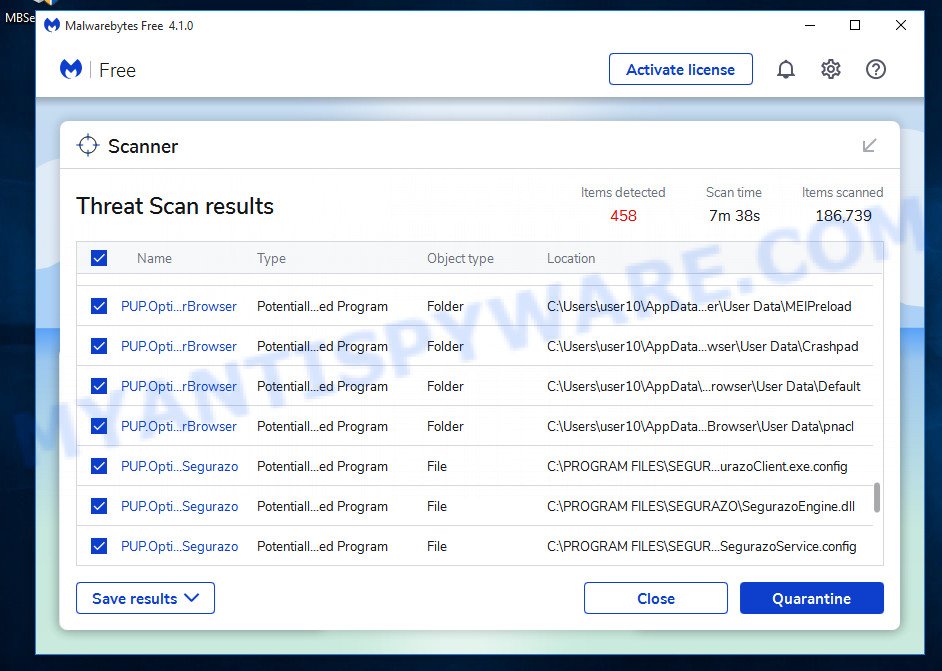
First, visit the page linked below, then click the ‘Download’ button in order to download the latest version of MalwareBytes.
327711 downloads
Author: Malwarebytes
Category: Security tools
Update: April 15, 2020
Once the downloading process is complete, run it and follow the prompts. Once installed, MalwareBytes will try to update itself and when this procedure is done, click the “Scan” button to perform a system scan with this utility for the FormsApp adware. A scan can take anywhere from 10 to 30 minutes, depending on the count of files on your computer and the speed of your personal computer. During the scan MalwareBytes AntiMalware will locate threats exist on your computer. Make sure all threats have ‘checkmark’ and click “Quarantine” button.
MalwareBytes AntiMalware is a free malware removal tool that you can use to remove all detected folders, files, services, registry entries and so on. To learn more about this software, we advise you to read and follow the steps or the video guide below.
There is another anti-malware tool that can remove adware for free and that is Zemana AntiMalware. It will scan Windows registry keys and files on your PC, as well as system settings and web browser add-ons. If it detects any malware, adware, or malicious add-on, Zemana will completely remove them from your PC.
Installing Zemana Anti-Malware is simple. First you will need to download it from the link below.
165490 downloads
Author: Zemana Ltd
Category: Security tools
Update: July 16, 2019
After the downloading process is complete, close all windows on your personal computer. Further, open the set up file named Zemana.AntiMalware.Setup. If the “User Account Control” prompt pops up like below, click the “Yes” button.
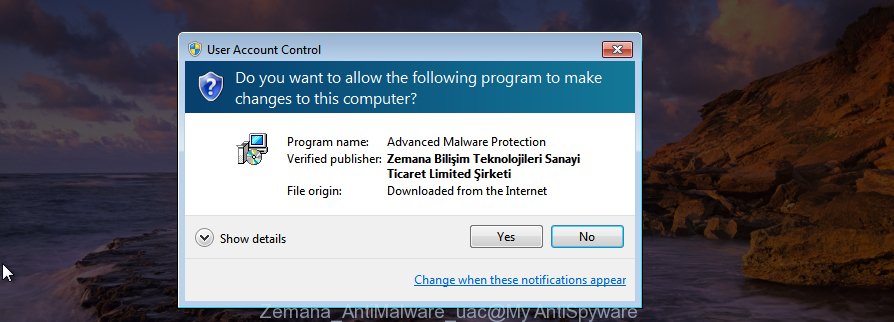
It will display the “Setup wizard” that will allow you install Zemana on the computer. Follow the prompts and do not make any changes to default settings.

Once the installation is done successfully, Zemana AntiMalware will automatically run and you can see its main window as displayed on the image below.

Next, click the “Scan” button to detect the FormsApp adware. A system scan can take anywhere from 5 to 30 minutes, depending on your computer. During the scan, Zemana Anti-Malware will search for security threats present on your computer.

Once Zemana has finished scanning your PC, it will display a list of security threats detected by the scan. When you are ready, click “Next” button.

Zemana AntiMalware will remove FormsApp and move the selected malicious entries to the program’s quarantine. After finished, you can be prompted to restart your PC.
Reset Google Chrome
In this step we are going to show you how to reset Google Chrome settings. Adware such as FormsApp can make changes to your web-browser settings, add toolbars and unwanted extensions. By resetting Chrome settings you will reset unwanted changes caused by adware. However, your saved passwords and bookmarks will not be changed, deleted or cleared.
First launch the Chrome. Next, click the button in the form of three horizontal dots (![]() ).
).
It will open the Google Chrome menu. Select More Tools, then press Extensions. Carefully browse through the list of installed addons. If the list has the extension signed with “Installed by enterprise policy” or “Installed by your administrator”, then complete the following steps: Remove Google Chrome extensions installed by enterprise policy.
Open the Chrome menu once again. Further, press the option named “Settings”.

The web browser will display the settings screen. Another method to display the Chrome’s settings – type chrome://settings in the internet browser adress bar and press Enter
Scroll down to the bottom of the page and click the “Advanced” link. Now scroll down until the “Reset” section is visible, as shown in the following example and click the “Reset settings to their original defaults” button.

The Google Chrome will display the confirmation dialog box as displayed on the image below.

You need to confirm your action, click the “Reset” button. The web browser will run the task of cleaning. Once it is finished, the internet browser’s settings including search provider by default, home page and newtab back to the values which have been when Google Chrome was first installed on your personal computer.
Reset Firefox
If your Firefox web browser is hijacked by FormsApp, then it may be time to perform the browser reset. Keep in mind that resetting your web-browser will not remove your history, bookmarks, passwords, and other saved data.
Start the Firefox and click the menu button (it looks like three stacked lines) at the top right of the internet browser screen. Next, click the question-mark icon at the bottom of the drop-down menu. It will open the slide-out menu.
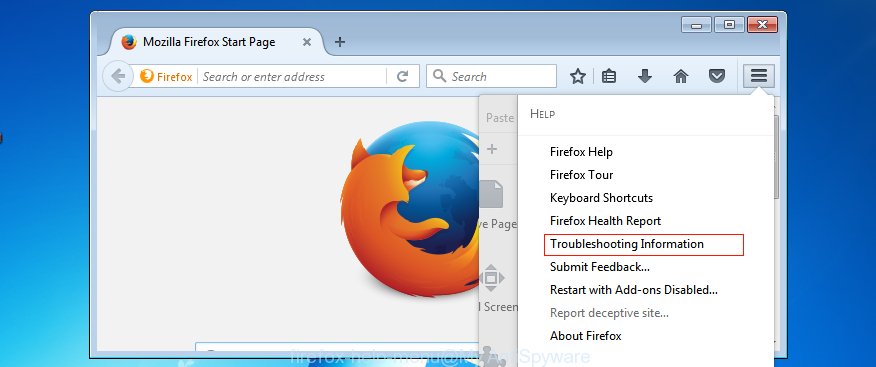
Select the “Troubleshooting information”. If you are unable to access the Help menu, then type “about:support” in your address bar and press Enter. It bring up the “Troubleshooting Information” page as displayed in the following example.

Click the “Refresh Firefox” button at the top right of the Troubleshooting Information page. Select “Refresh Firefox” in the confirmation prompt. The Firefox will start a process to fix your problems that caused by the FormsApp adware. Once, it is finished, click the “Finish” button.
How to stay safe online
If you browse the Web, you can’t avoid malicious ads and scam sites. But you can protect your internet browser against it. Download and use an ad blocking program. AdGuard is an ad-blocker which can filter out a huge number of of the malicious advertising, blocking dynamic scripts from loading harmful content.
- First, visit the following page, then click the ‘Download’ button in order to download the latest version of AdGuard.
Adguard download
27033 downloads
Version: 6.4
Author: © Adguard
Category: Security tools
Update: November 15, 2018
- When the downloading process is complete, start the downloaded file. You will see the “Setup Wizard” program window. Follow the prompts.
- After the installation is complete, press “Skip” to close the installation program and use the default settings, or press “Get Started” to see an quick tutorial which will help you get to know AdGuard better.
- In most cases, the default settings are enough and you don’t need to change anything. Each time, when you run your computer, AdGuard will launch automatically and stop unwanted advertisements, block harmful and misleading webpages. For an overview of all the features of the program, or to change its settings you can simply double-click on the icon called AdGuard, which can be found on your desktop.
Finish words
We suggest that you keep Malwarebytes Anti-Malware (to periodically scan your device for new adware and other malware) and AdGuard (to help you stop malicious pop-ups and scam sites). Moreover, to prevent any adware, please stay clear of unknown and third party programs, make sure that your antivirus software, turn on the option to search for potentially unwanted programs.
If you need more help with FormsApp related issues, go to here.



















